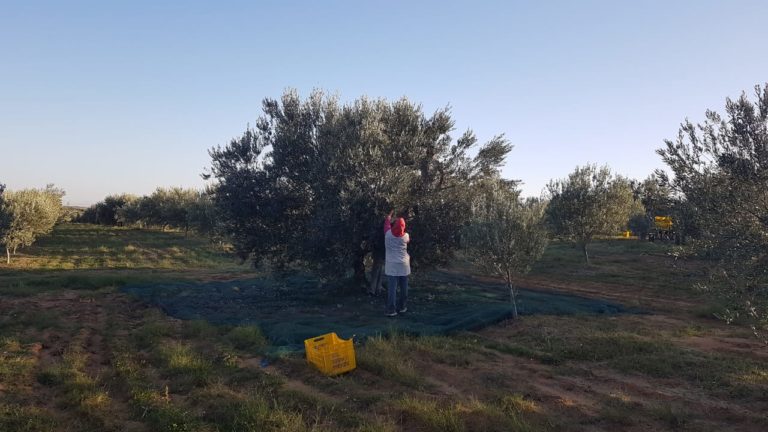The Grand Tour
From the Field to the Bottle.
Olive trees pass by different steps so that they will turn out into a beautiful product. Usually, the harvesting of olives starts at the beginning of Fall and lasts until late December and it differs from one zone to another depending on the freshness or dryness of the summer season along with the maturity of the olives in different areas. In Masclianae, and given the intrinsic characteristics of the OUESLATI variety, it, therefore, starts at the end of October and lasts until the end of the first half of November. Here’s a secret, this is the perfect timing to collect the olive fruits since the quality of the extracted olive oil is superior due to its high content of polyphenols and its exceptional sensory attributes. The olives picked are all selected on-site by the farmers and must be especially free of overripe olives that have already fallen to the ground.


These hand-picked fruits are carefully selected. The harvesting is carried out by qualified workers from the region. These locals inherited the gentle techniques of harvesting from their previous generations and antecedents. Since they are used to thinking sustainably, they know well how to take care of the tree during the process of collecting so they separate the olives from the branches gently without damaging the trees to keep them in good condition for the next seasons. This process is crucial as it is the first step of the transformation of the olives.
In order to preserve the freshness of the olives, they are then put in well-ventilated plastic crates to be restored and delivered to the oil mill. Therefore, the workers need to bear in mind that special care must be ensured during the storage as it is primordial and matters in the next steps starting from the harvest until the crushing.


The olive crates are then transported on the same day for a very special reason, which is to maintain the very low level of acidity of the oil and to preserve its sensory attributes. The olives are eventually transported to the oil mill and crushed the same day. The latter is equipped with a two-phase mill that is used for cold crushing between 20 and 30° C.
Here’s a hint, this temperature depends highly on the stage of maturity of the olives.
The period of the crushing process ranges from 30 to 40 minutes. This crushing stage, as well as the judicious choice of the working temperature, play a crucial role in obtaining excellent quality olive oil.
This cold-pressed olive oil is graded as an «Extra Virgin Olive» according to its organoleptic and physicochemical properties fixed By International Olive Council (IOC) standards. As a matter of fact, Oueslati oil is characterised by a high percentage of oleic acid which is estimated to reach 76% on average at maturity. It also includes a very low percentage of palmitic acid, which allows it to keep its fluid consistency even at low temperatures. Added to that, the percentage of essential linoleic acid in our olive oil is between 11 and 13% which is ideal for the human body. Accordingly, numerous research has shown that this latter improves insulin sensitivity and plays a major role in keeping the blood pressure constant. In addition, this variety has a very stable oil even when fully ripe (stability = 48 h).

To ensure maximum freshness over time, the olive oil is filtered and then stored under nitrogen in stainless steel food containers to avoid deteriorative changes in the chemical and nutritional properties. Sometimes and according to our customer’s request, our olive oil can be supplied without filtration but rather with simple decantation. This involves the separation of the oil to get rid of the unfiltered sediments that settle at the bottom.
Now that our product is fresh and restored, it is now ready for shipping. Our professionals will make sure of the smooth running of the transportation process.

